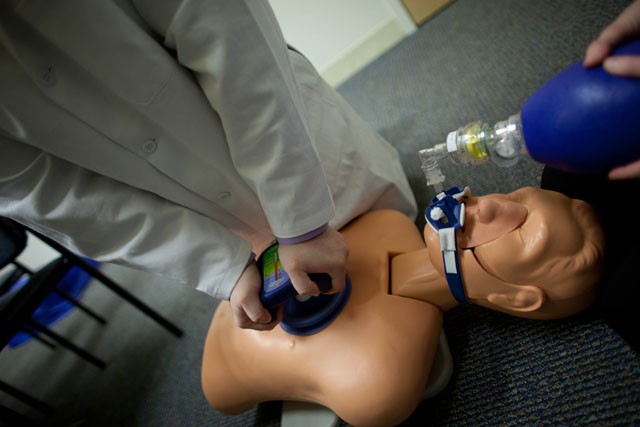The origins of a new CPR method gaining steam in the medical world involve the University of Minnesota and a plunger.
Twenty years ago, Keith Lurie âÄî now a University professor of emergency medicine âÄî was working in San Francisco when he treated a patient suffering from cardiac arrest. The manâÄôs family told Lurie they had kept him alive by using a toilet plunger.
Their creativity sparked an idea that was eventually developed and researched at the University.
This new method involves two devices that circulate blood to the heart and brain better than traditional hand-to-chest CPR, according to a five-year study on the techniqueâÄôs effectiveness.
The study âÄî which was initiated by Lurie âÄî concluded that the new method stimulated three times as much blood flow and improved chances of survival with good brain function in cardiac arrest victims by 50 percent.
Cardiac arrest occurs when the heart fails to contract correctly, which disrupts normal blood circulation throughout the body. A heart attack, which can cause cardiac arrest, is the death of heart tissue caused by a disruption of blood flow to part of the heart.
“We are moving from prehistoric times âÄî relying only on our hands âÄî to modern times, implementing tools to treat victims,” Lurie said in a statement.
Rather than using a plunger, the chest pump has a five-inch suction cup with a large blue handle to compress and decompress the chest.
“By pulling up, you make the filling process of the heart active instead of passive,” Demetris Yannopoulos, assistant professor of medicine at the University, said as he demonstrated the pump on the torso of a dummy.
The second device attaches to a facemask or breathing tube and limits the amount of air that enters the chest while the pump is pulled up. Too much air rushing into the lungs would cancel out the vacuum effect that helps blood circulation, Yannopoulos said.
The ResQPump and ResQPOD were developed by Advanced Circulatory Systems Inc. âÄî a medical technology company in Roseville, Minn., that Lurie co-founded.
The research was funded by the National Institutes of Health, and although ACSI was the sponsor of the study, Lurie and the rest of the company were restricted from the data and had no contact with the patients involved, ACSI Clinical Marketing Director Terry Provo said.
ACSI money was only used to pay for outside analysis of the data or if NIH money ran out before the next funding cycle began, she said.
Data from the study will be sent to the Federal Drug Administration this month for approval to sell the chest pump in the U.S., Provo said. That review process takes 12 to 18 months, she said.
The authors of the study suggested that this new CPR method be an alternative to the standard technique, but any placement or practical use wonâÄôt be determined until the chest pump is approved by the FDA.
Hand-to-chest CPR has been the standard treatment for out-of-hospital cardiac arrest since it was developed at Johns Hopkins University roughly 50 years ago.
Emergency medical services in the U.S. perform CPR on about 300,000 cardiac arrest victims each year, according to the American Heart Association. An estimated 95 percent of those victims die before reaching the hospital.
CPR itself typically cannot restore a victimâÄôs regular heart function âÄî an electric shock, or defibrillation, is necessary.
One downside of the ACSI system is that pulling up on the pump makes it more labor intensive, “but far more efficient,” Yannopoulos said.
Over five years, researchers gathered data from seven regions across the country, including the Twin Cities. EMS professionals administered either standard CPR or used the ACSI system and compared the survival rates for up to a year.
Nine percent of patients who were treated with the new method survived at least a year, compared to 6 percent of those who received traditional CPR.
The American Heart Association doesnâÄôt comment on specific devices, said AHA Government Relations Director for Minnesota Justin Bell. AHA supports any research into any life-saving techniques, but its focus remains elsewhere, he said.
“What the AHA really pushes is bystander training, particularly hands-only chest compressions.”


